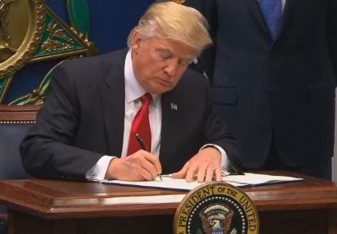
The discrepancies found by USA Today show the Trump administration evidently made a number of changes from fixing small typographical and grammatical mistakes all the way to having to correct references to incorrect or even nonexistent legal provisions in the U.S. Code before they submitted the orders to the Federal Register.
The Federal Register is the official journal of the U.S. government and it is legally controlling. It contains public notices, proposed rule changes, new rules for federal agencies and presidential Executive Orders. It is codified and then annually published as the Code of Federal Regulations.
The newspaper says its findings are significant because the Federal Register version is often not published until days after the action is taken and what appears on the White House website is often all the public has to rely on for its information.
Trump’s Executive Orders have generally been signed in highly public ceremonies, and afterwards the official document containing the president’s signature is then given to the Office of the Federal Register. An an assistant to the director of the Office of the Federal Register told the newspaper the office does not make any changes to documents once they are signed because they cannot modify a legally binding document.
“Once the president’s signature is on that, that’s a legal document that we would never change,” assistant Jim Hemphill said to the newspaper.
Perhaps the most significant inaccuracy was found in Trump’s “extreme vetting” Executive Order, a portion of which required the Secretary of State to enforce a section of the U.S. Code that calls for in-person interviews with every individual (from certain countries) that sought a non-immigrant visa to visit the United States. However, text of the order posted on the White House website referred to 8 U.S.C. Section 1222 — a provision of law that requires a mental and physical examination. Not 8 U.S.C. Section 1202 that requires the in-person interview. The Federal Register version contains the corrected statutory language.
Another glaring mistake can found in Trump’s Executive Order on ethical standards for the appointment of members of the administration. The White House version contains a reference to a nonexistent provision of the U.S. Code — “section 207 of title 28” — while the Federal Register version was corrected to reference the correct provision of law, 18 U.S.C. Section 207.
Other, less significant changes, were found in at least one additional Executive Order and in two presidential memoranda.
John Wonderlich, the director of a government transparency advocacy group called the Sunlight Foundation, told the newspaper the changes may indicate a deeper problem with the review process within the administration for Executive Orders.
“These last-minute edits suggest the Trump White House needs to revisit their vetting, sign-off, and publication processes for executive orders,” Wonderlich explained.
[image via screengrab]